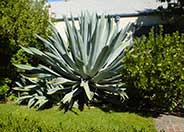
Common name:Century Plant, Maguey
Botanical name:Agave americana
This plant is fast growing to about 6'-10' tall and 8'-13' wide. Wide gray leaves have stiff terminal spines and recurved teeth on margins. It prefers full sun and well-drained situations. After blooming, which could take several years, it will die but will send up new pups from around the base. Some people are allergic to the sap. Removal is difficult if unwanted.

Common name:Variegated Century Plant
Botanical name:Agave americana 'Variegata'
This Agave has a creamy yellow margins around the edge of the leaves. It will grow 6'-10' tall by up to 13' wide. It is native to Mexico. It has a very open growth habit, with leaves that recurve along their length. -Mountain States Nursery

Common name:Hybrid White Rockrose
Botanical name:Cistus hybridus
This is a small evergreen shrub with 2" long gray green, crinkly leaves. It has pure white flowers with prominent yellow stamens. It flowers throughout the spring to early summer. Avoid heavy mulches. .

Common name:Matilija Poppy
Botanical name:Romneya coulteri
Crowned by white poppies, this high-impact, spreading, gray green perennial stands statuesque at 5"-8" tall. It is best used where its scale and habit will not overpower, and it requires no summer water and thrives on dry alluvial slopes..

Common name:Huntington Carpet Rosemary
Botanical name:Rosmarinus officinalis 'Huntington Carpe
In comparison to other varieties of the Rosmarinus, the 'Huntington Carpet' is less woody, and the leaf color is much greener. Also, it maintains a center foliage better that other prostrates.

Common name:Yankee Point California Lilac
Botanical name:Ceanothus griseus hor. 'Yankee Point'
Yankee Point is a fast growing shrub that stays near 3' in height with a spread of 6'. It has large, bright green leaves and light blue flowers. It is great for banks and mass plantings. It does well on the coast and in hot inland areas. It attracts hummingbirds, butterflies and beneficial insects. -Cornflower Farms
Solving Runoff Problems
Importance of Watershed
A watershed is a land area that drains rain and other water into a creek, river, lake, wetland, or groundwater aquifer. Water from your neighborhood also enters the watershed through the storm drain system and flows directly to local creeks without any treatment. It often is contaminated by pollutants that can be toxic to fish, wildlife, and people.Click in the green box for more information
| Designer: | Backyard Blends into Open Space |
Photographer: GardenSoft |
Soils and Compost:
Practice grass-cycling by leaving short grass clippings on lawns after mowing, so that nutrients and organic matter are returned to the soil.
Water Saving Tip:
Be sure to fix all leaks promptly no matter how small they may seem.
Integrated Pest Management:
Remove irrigation water and fertilizer from areas where you don't want weeds to grow.

